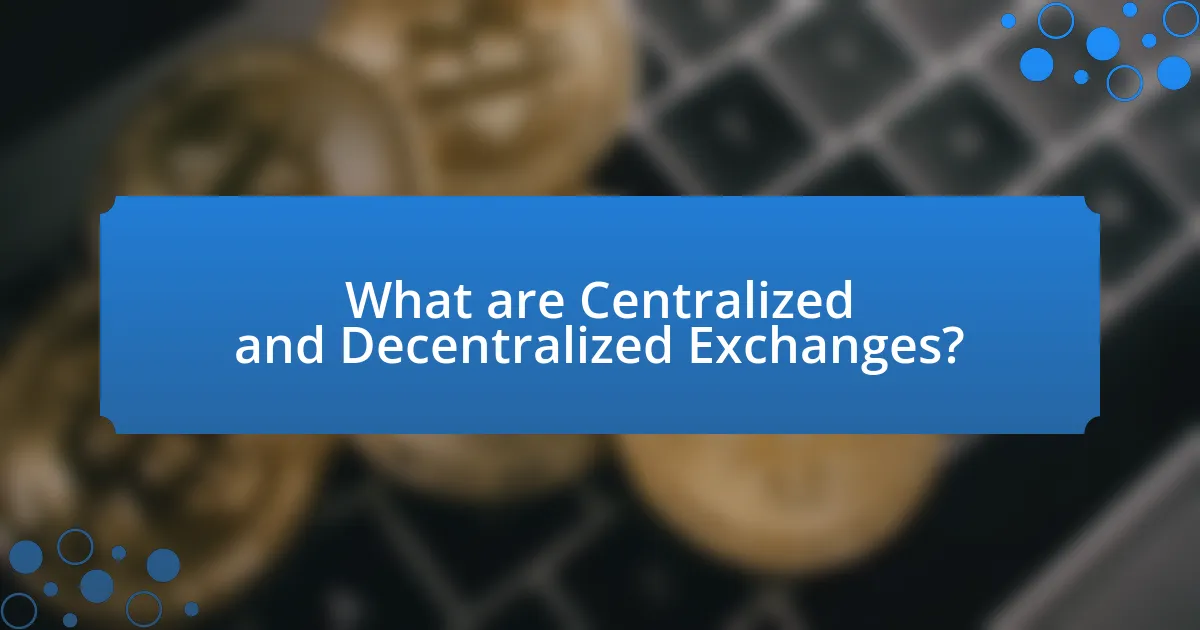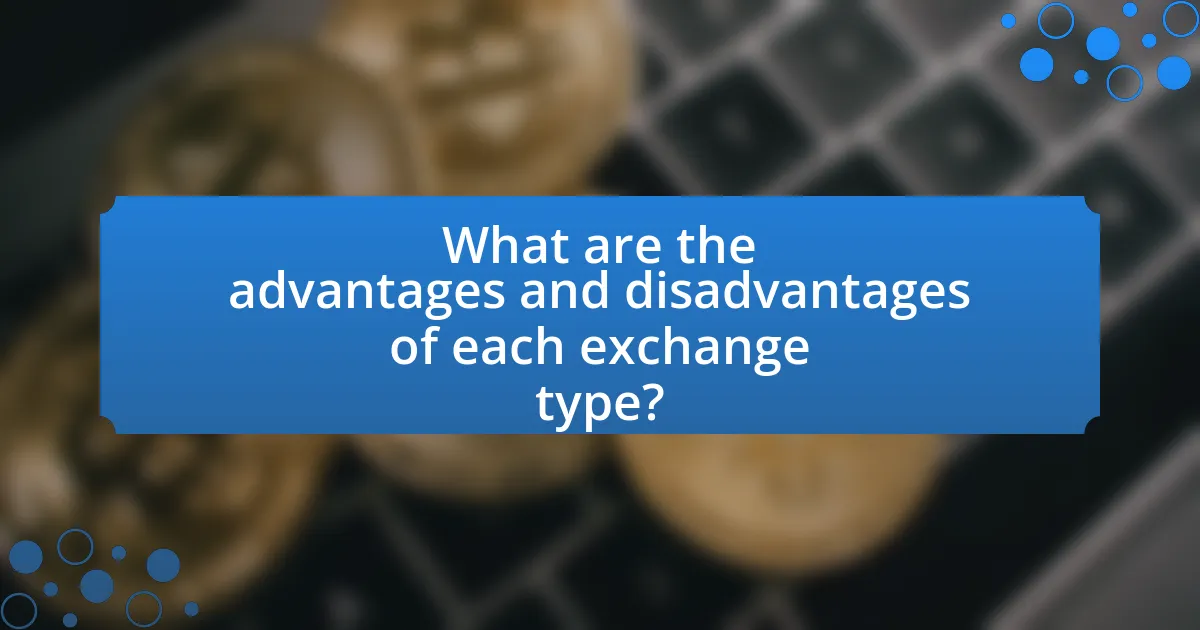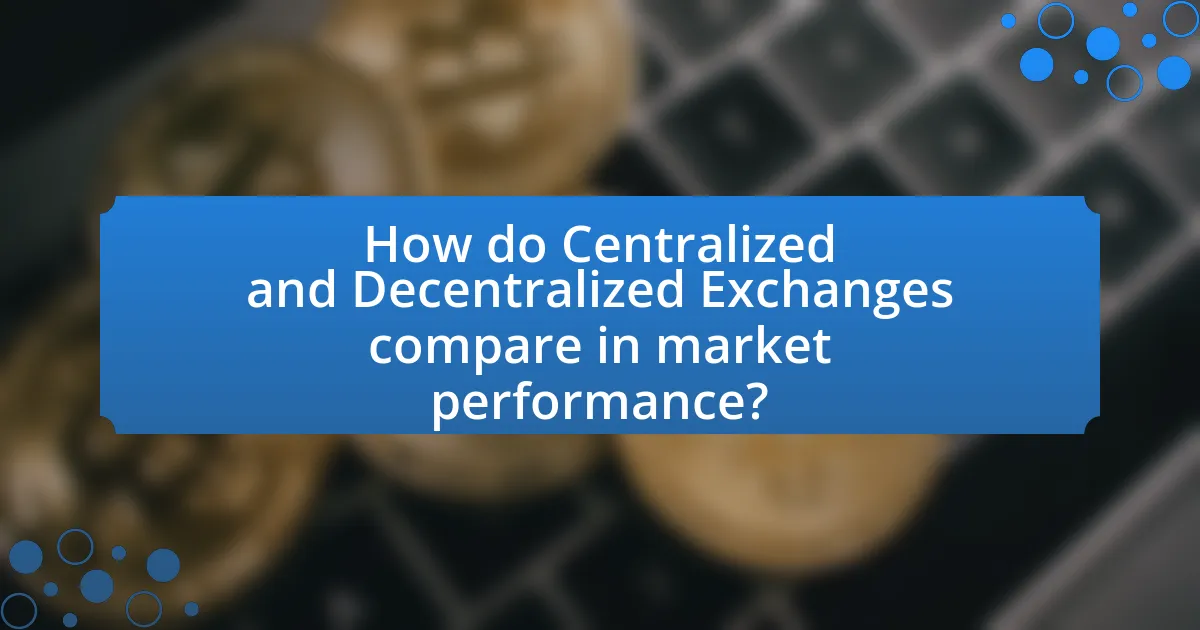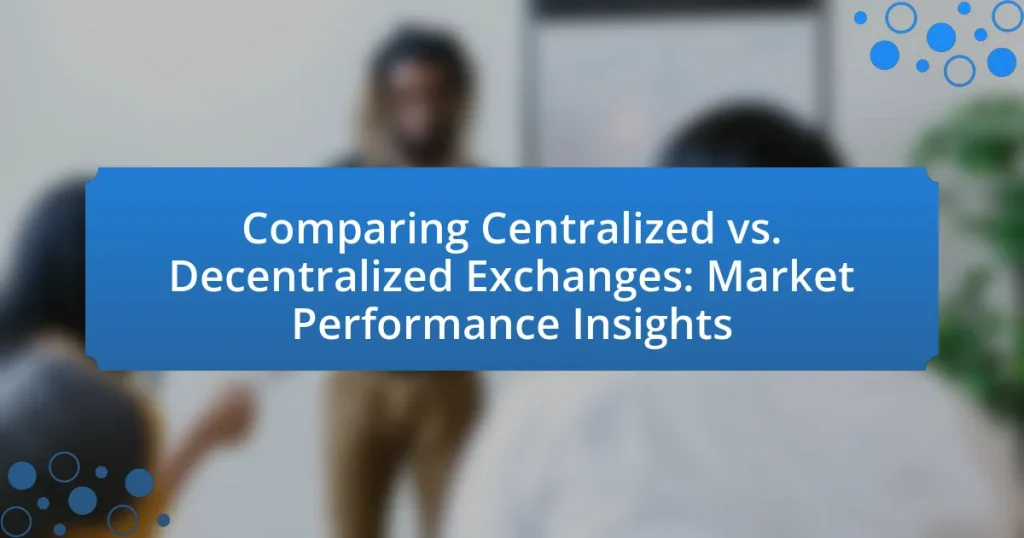Centralized and decentralized exchanges (CEXs and DEXs) are two primary platforms for cryptocurrency trading, each with distinct operational models and features. CEXs are managed by central authorities, offering high liquidity, user-friendly interfaces, and robust security measures, but they also pose risks such as hacks and regulatory scrutiny. Conversely, DEXs facilitate peer-to-peer trading through smart contracts, providing enhanced privacy and control over funds, though they may experience lower liquidity and higher transaction fees. This article compares the market performance of CEXs and DEXs, examining their advantages, disadvantages, security measures, and emerging trends, while also considering user demographics and factors influencing exchange choice.

What are Centralized and Decentralized Exchanges?
Centralized exchanges (CEXs) are platforms where transactions are facilitated by a central authority, which manages the order book and holds users’ funds. In contrast, decentralized exchanges (DEXs) operate without a central authority, allowing users to trade directly with one another through smart contracts on a blockchain. CEXs typically offer higher liquidity and faster transaction speeds, while DEXs provide greater privacy and control over funds. According to a report by CoinGecko, as of 2023, centralized exchanges account for approximately 70% of the total cryptocurrency trading volume, highlighting their dominance in the market.
How do Centralized Exchanges operate?
Centralized exchanges operate by acting as intermediaries between buyers and sellers in cryptocurrency trading. These platforms facilitate transactions by matching orders from users, managing the custody of assets, and providing liquidity. Centralized exchanges typically require users to create accounts and deposit funds, which the exchange holds in its wallets. This model allows for faster transaction processing and a user-friendly experience, as the exchange handles the complexities of trading, including order matching and market making. According to a report by CoinMarketCap, centralized exchanges accounted for over 90% of cryptocurrency trading volume in 2021, highlighting their dominance in the market.
What are the key features of Centralized Exchanges?
Centralized exchanges are platforms that facilitate the buying, selling, and trading of cryptocurrencies through a centralized authority. Key features include user-friendly interfaces, high liquidity, and robust security measures. User-friendly interfaces allow traders to easily navigate the platform, while high liquidity ensures that users can execute trades quickly and at stable prices. Additionally, centralized exchanges often implement advanced security protocols, such as two-factor authentication and cold storage for funds, to protect user assets. These features contribute to the popularity and efficiency of centralized exchanges in the cryptocurrency market.
What security measures do Centralized Exchanges implement?
Centralized exchanges implement several security measures to protect user assets and data. These measures include two-factor authentication (2FA), which adds an extra layer of security by requiring users to provide two forms of identification before accessing their accounts. Additionally, centralized exchanges often utilize cold storage for the majority of their digital assets, keeping them offline to reduce the risk of hacking. Regular security audits and penetration testing are conducted to identify and rectify vulnerabilities in their systems. Furthermore, many exchanges have insurance policies in place to cover potential losses from breaches, enhancing user trust. According to a report by CipherTrace, exchanges that implement these security protocols significantly reduce the likelihood of successful cyberattacks.
How do Decentralized Exchanges operate?
Decentralized exchanges operate by enabling peer-to-peer trading of cryptocurrencies without the need for an intermediary. These platforms utilize smart contracts on blockchain technology to facilitate transactions directly between users, ensuring that trades are executed automatically when predefined conditions are met. For instance, Uniswap, a prominent decentralized exchange, employs an automated market maker (AMM) model, allowing users to provide liquidity and earn fees while maintaining control over their assets. This structure enhances security and privacy, as users retain ownership of their funds throughout the trading process, contrasting with centralized exchanges where assets are held by the platform.
What are the key features of Decentralized Exchanges?
Decentralized exchanges (DEXs) are platforms that facilitate peer-to-peer trading of cryptocurrencies without the need for an intermediary. Key features of DEXs include enhanced privacy, as users retain control of their private keys and personal data; increased security, since funds are not held in a central location that can be hacked; and greater accessibility, allowing anyone with an internet connection to trade without the need for registration or KYC processes. Additionally, DEXs often utilize smart contracts to automate trades, ensuring transparency and reducing the risk of fraud. According to a report by CoinGecko, DEXs accounted for over 20% of total cryptocurrency trading volume in 2021, highlighting their growing significance in the market.
What security measures do Decentralized Exchanges implement?
Decentralized exchanges implement several security measures to protect users and their assets. These measures include smart contract audits, which ensure that the code governing the exchange is free from vulnerabilities; the use of multi-signature wallets, which require multiple approvals for transactions, thereby reducing the risk of unauthorized access; and liquidity pools that allow users to trade directly from their wallets, minimizing the need to deposit funds into the exchange. Additionally, decentralized exchanges often utilize decentralized governance models, enabling community oversight and reducing the risk of centralized control or manipulation. These practices collectively enhance the security and trustworthiness of decentralized exchanges in the cryptocurrency ecosystem.

What are the advantages and disadvantages of each exchange type?
Centralized exchanges (CEX) offer advantages such as high liquidity, user-friendly interfaces, and robust security measures, making them accessible for beginners. However, they also have disadvantages, including the risk of hacks, regulatory scrutiny, and the requirement for users to trust a third party with their funds. In contrast, decentralized exchanges (DEX) provide advantages like enhanced privacy, control over funds, and reduced reliance on intermediaries, appealing to users who prioritize autonomy. Nonetheless, DEX face disadvantages such as lower liquidity, potentially higher transaction fees, and a steeper learning curve for new users. These characteristics highlight the trade-offs between convenience and control in the cryptocurrency trading landscape.
What are the benefits of using Centralized Exchanges?
Centralized exchanges offer several benefits, including enhanced liquidity, user-friendly interfaces, and robust security measures. Enhanced liquidity allows for quicker transactions and better price stability, as centralized exchanges typically have a larger pool of buyers and sellers. User-friendly interfaces simplify the trading process, making it accessible for beginners. Additionally, centralized exchanges often implement advanced security protocols, such as two-factor authentication and cold storage, to protect users’ assets. These factors contribute to a more efficient trading experience compared to decentralized exchanges.
How do Centralized Exchanges enhance user experience?
Centralized exchanges enhance user experience by providing a streamlined and user-friendly interface for trading cryptocurrencies. These platforms typically offer features such as instant transactions, high liquidity, and customer support, which facilitate easier trading for users. For instance, centralized exchanges like Binance and Coinbase have invested in intuitive designs and mobile applications that simplify the trading process, making it accessible even for beginners. Additionally, they often implement robust security measures, such as two-factor authentication and cold storage for funds, which instill confidence in users regarding the safety of their assets. According to a report by CoinMarketCap, centralized exchanges account for over 90% of cryptocurrency trading volume, indicating their popularity and effectiveness in meeting user needs.
What risks are associated with Centralized Exchanges?
Centralized exchanges pose several risks, including security vulnerabilities, regulatory compliance issues, and market manipulation. Security vulnerabilities arise from the centralized nature of these platforms, making them attractive targets for hackers; for instance, the 2014 Mt. Gox hack resulted in the loss of approximately 850,000 Bitcoins, highlighting the potential for significant financial loss. Regulatory compliance issues can lead to legal repercussions, as exchanges must navigate complex regulations that vary by jurisdiction; failure to comply can result in fines or shutdowns. Additionally, market manipulation can occur due to the lack of transparency and oversight, allowing for practices such as wash trading, which can distort market prices and harm investors.
What are the benefits of using Decentralized Exchanges?
Decentralized exchanges (DEXs) offer several benefits, including enhanced security, greater privacy, and reduced reliance on intermediaries. Security is improved because users retain control of their private keys, minimizing the risk of hacks that often affect centralized exchanges. Greater privacy is achieved as DEXs typically do not require extensive personal information for trading, allowing users to maintain anonymity. Additionally, DEXs operate on a peer-to-peer basis, which reduces the need for intermediaries, thereby lowering transaction fees and enabling faster trades. According to a report by CoinGecko, DEXs have seen a significant increase in trading volume, highlighting their growing popularity and effectiveness in the cryptocurrency market.
How do Decentralized Exchanges enhance user privacy?
Decentralized exchanges enhance user privacy by allowing transactions to occur directly between users without the need for an intermediary. This peer-to-peer model means that users do not have to provide personal information, such as names or addresses, to trade assets. Additionally, decentralized exchanges often utilize blockchain technology, which provides a level of anonymity through pseudonymous wallet addresses. According to a report by Chainalysis, decentralized exchanges accounted for 12% of all cryptocurrency transactions in 2020, highlighting their growing popularity among users seeking privacy.
What risks are associated with Decentralized Exchanges?
Decentralized exchanges (DEXs) are associated with several risks, including smart contract vulnerabilities, lack of regulatory oversight, and liquidity issues. Smart contract vulnerabilities can lead to hacks or exploits, as seen in incidents like the 2020 hack of the DeFi platform bZx, which resulted in a loss of $8 million due to a flaw in its smart contract. The lack of regulatory oversight means users may have limited recourse in cases of fraud or disputes, unlike centralized exchanges that often have consumer protection measures. Additionally, liquidity issues can arise, making it difficult for users to execute large trades without significant price slippage, as evidenced by lower trading volumes on some DEXs compared to their centralized counterparts.

How do Centralized and Decentralized Exchanges compare in market performance?
Centralized exchanges (CEXs) generally outperform decentralized exchanges (DEXs) in market performance due to higher trading volumes and liquidity. For instance, as of 2023, CEXs like Binance and Coinbase have consistently reported daily trading volumes exceeding $1 billion, while DEXs like Uniswap and SushiSwap typically see volumes around $100 million. This disparity in volume leads to tighter spreads and faster transaction times on CEXs, making them more attractive for traders seeking efficiency. Additionally, CEXs often provide advanced trading features and customer support, further enhancing their market appeal compared to DEXs, which prioritize user autonomy and security but may lack the same level of performance and user experience.
What metrics are used to evaluate the performance of exchanges?
The primary metrics used to evaluate the performance of exchanges include trading volume, liquidity, order book depth, and market share. Trading volume indicates the total amount of assets traded over a specific period, reflecting the exchange’s activity level; for instance, a higher trading volume often correlates with greater user engagement and trust. Liquidity measures how easily assets can be bought or sold without significantly affecting their price, with higher liquidity indicating a more efficient market. Order book depth assesses the number of buy and sell orders at various price levels, providing insight into market stability and potential price volatility. Market share represents the percentage of total trading activity that an exchange captures, highlighting its competitive position within the industry. These metrics collectively provide a comprehensive view of an exchange’s operational effectiveness and market presence.
How does trading volume differ between Centralized and Decentralized Exchanges?
Trading volume on Centralized Exchanges (CEXs) is typically higher than on Decentralized Exchanges (DEXs). This difference is primarily due to the liquidity provided by CEXs, which often have larger user bases and institutional participation, resulting in daily trading volumes that can reach billions of dollars. For instance, in 2021, Binance, a leading CEX, reported daily trading volumes exceeding $2 billion, while DEXs like Uniswap had daily volumes around $1 billion, reflecting a significant disparity. Additionally, CEXs offer faster transaction speeds and user-friendly interfaces, attracting more traders, while DEXs, despite their growing popularity, often face challenges such as lower liquidity and higher slippage, which can deter trading activity.
What role does liquidity play in exchange performance?
Liquidity is crucial for exchange performance as it directly influences trading efficiency and price stability. High liquidity allows for quicker transactions and narrower bid-ask spreads, which enhances user experience and attracts more traders. For instance, centralized exchanges like Binance and Coinbase typically exhibit higher liquidity due to their larger user bases and trading volumes, resulting in more competitive pricing and reduced slippage. Conversely, decentralized exchanges often struggle with lower liquidity, which can lead to higher volatility and less favorable trading conditions. Data from CoinMarketCap shows that exchanges with higher liquidity consistently rank better in terms of user engagement and transaction volume, underscoring the importance of liquidity in overall exchange performance.
How do user demographics affect exchange performance?
User demographics significantly affect exchange performance by influencing trading behavior, liquidity, and market volatility. For instance, younger traders, who are often more tech-savvy, tend to favor decentralized exchanges, leading to increased trading volumes in those platforms. Conversely, older demographics may prefer centralized exchanges due to their perceived security and user-friendly interfaces, which can stabilize liquidity. Research indicates that demographic factors such as age, income, and education level correlate with trading frequency and asset preferences, impacting overall market dynamics. For example, a study by the CFA Institute found that younger investors are more likely to engage in high-frequency trading, which can lead to increased volatility in exchanges catering to that demographic.
What types of users prefer Centralized Exchanges?
Users who prefer Centralized Exchanges typically include beginners, institutional investors, and those seeking convenience. Beginners favor these platforms due to their user-friendly interfaces and customer support, which simplify the trading process. Institutional investors are attracted to centralized exchanges for their liquidity and regulatory compliance, which facilitate large transactions. Additionally, users who prioritize ease of access and a wide range of trading pairs often choose centralized exchanges, as they provide a more straightforward trading experience compared to decentralized alternatives.
What types of users prefer Decentralized Exchanges?
Users who prefer Decentralized Exchanges (DEXs) typically include privacy-conscious individuals, experienced traders, and those seeking greater control over their assets. Privacy-conscious individuals favor DEXs because these platforms do not require personal information, allowing for anonymous trading. Experienced traders are drawn to DEXs for their advanced trading features and the ability to access a wider range of tokens without the limitations often imposed by centralized exchanges. Additionally, users seeking greater control over their assets prefer DEXs since they allow users to retain custody of their funds, reducing the risk of hacks or mismanagement associated with centralized platforms.
What trends are emerging in the exchange market?
Emerging trends in the exchange market include the increasing adoption of decentralized exchanges (DEXs) and the integration of blockchain technology into traditional centralized exchanges (CEXs). DEXs are gaining popularity due to their enhanced security, user control over funds, and reduced reliance on intermediaries, with platforms like Uniswap and SushiSwap leading the way. In contrast, CEXs are evolving by incorporating features such as automated market-making and liquidity pools, which aim to improve user experience and efficiency. According to a report by Chainalysis, decentralized finance (DeFi) transactions surged to over $100 billion in 2021, highlighting the growing shift towards DEXs. Additionally, regulatory scrutiny is increasing, prompting both CEXs and DEXs to enhance compliance measures, which is shaping the future landscape of the exchange market.
How is the adoption of Decentralized Exchanges changing the market landscape?
The adoption of Decentralized Exchanges (DEXs) is significantly transforming the market landscape by enhancing user autonomy and reducing reliance on centralized entities. DEXs allow users to trade directly from their wallets, which minimizes the risk of hacks associated with centralized exchanges, as evidenced by the fact that over $1 billion was lost to hacks in centralized platforms in 2020 alone. Furthermore, DEXs promote greater market efficiency by enabling peer-to-peer transactions and fostering competition, which can lead to lower trading fees. According to a report by Dune Analytics, DEX trading volume surpassed $1 trillion in 2021, indicating a growing preference among traders for decentralized solutions. This shift is also reflected in the increasing number of users engaging with DEXs, which reached over 2 million unique wallets in 2021, highlighting a significant change in trading behavior and market dynamics.
What future developments can we expect for Centralized Exchanges?
Future developments for centralized exchanges will likely include enhanced regulatory compliance, improved security measures, and the integration of advanced trading technologies. Regulatory compliance is becoming increasingly important as governments worldwide implement stricter guidelines for cryptocurrency trading; for instance, the Financial Action Task Force (FATF) has set standards that many exchanges are beginning to adopt. Improved security measures will be essential to protect user assets, especially in light of high-profile hacks; centralized exchanges are investing in multi-signature wallets and cold storage solutions to mitigate risks. Additionally, the integration of technologies such as artificial intelligence and machine learning will facilitate better trading algorithms and user experiences, as seen in platforms that already utilize these technologies to analyze market trends and optimize trading strategies.
What should users consider when choosing between Centralized and Decentralized Exchanges?
Users should consider factors such as security, control, liquidity, and user experience when choosing between Centralized and Decentralized Exchanges. Centralized Exchanges typically offer higher liquidity and faster transaction speeds, making them suitable for users prioritizing efficiency. However, they require users to trust the platform with their funds, which can pose security risks, as evidenced by high-profile hacks like the Mt. Gox incident in 2014. In contrast, Decentralized Exchanges provide users with greater control over their assets and enhanced privacy, as they do not require personal information. However, they often face challenges with lower liquidity and slower transaction times. Users should weigh these aspects based on their individual needs and risk tolerance.
What factors should influence a user’s choice of exchange type?
A user’s choice of exchange type should be influenced by factors such as security, control over funds, transaction fees, liquidity, and regulatory compliance. Security is paramount; centralized exchanges often have higher risks of hacks, while decentralized exchanges provide users with greater control over their assets, reducing the risk of loss. Transaction fees vary significantly; centralized exchanges may charge higher fees for trades, while decentralized exchanges often have lower fees but may incur gas costs. Liquidity is another critical factor; centralized exchanges typically offer higher liquidity, facilitating faster trades, whereas decentralized exchanges may experience lower liquidity, impacting trade execution. Lastly, regulatory compliance is essential; users must consider the legal implications of using either type of exchange, as centralized exchanges are often subject to stricter regulations compared to decentralized platforms.
How can users mitigate risks associated with each exchange type?
Users can mitigate risks associated with centralized exchanges by enabling two-factor authentication, using strong passwords, and withdrawing funds to secure wallets after trading. Centralized exchanges are often targets for hacking, with incidents like the Mt. Gox hack in 2014 resulting in the loss of 850,000 Bitcoins, highlighting the importance of security measures.
For decentralized exchanges, users can reduce risks by conducting thorough research on the platform’s smart contracts, using reputable wallets, and avoiding sharing private keys. The lack of a central authority in decentralized exchanges can lead to vulnerabilities in smart contracts, as seen in the 2020 bZx exploit, where $8 million was lost due to a flaw in the protocol.


